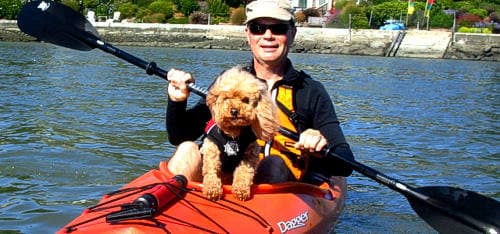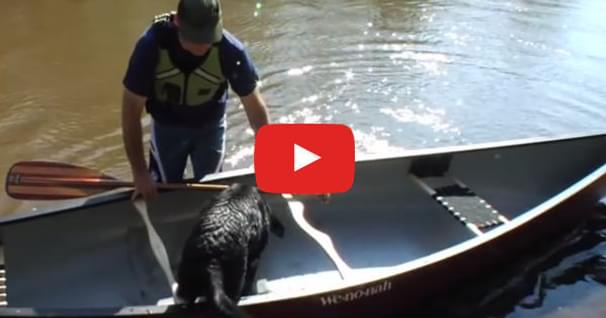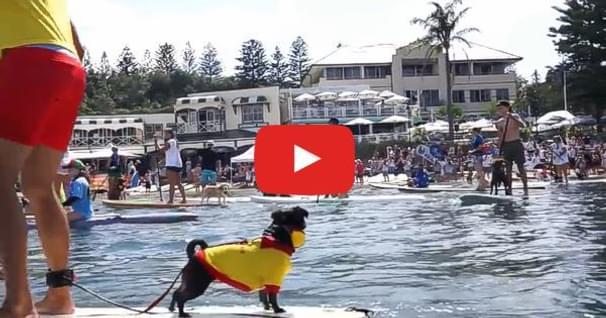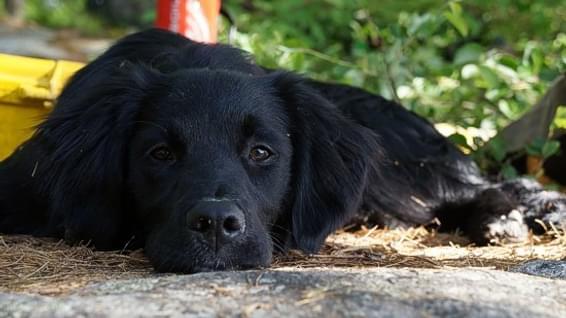Putting The Doggy into Paddling
One of the best things about having a dog in your life is that they're always up for an adventure with you. Better still, they seldom complain about the car ride, the walk to put in, the sleeping arrangements or the food. They are the perfect companion for the outdoors, and on-water adventures are no exception. Despite having no opposable thumbs -- which seriously limits their ability to do anything but give unconditional love, ballast and entertainment on family paddling trips -- dogs love being with you even it it means going outside of their watery comfort zone.
Many, and in fact most, dogs love to swim and certain breeds are beautifully designed for the water. With large, web-like feet the Newfoundland and some Spaniel breeds are as at home on water as on land; and the Labrador's affinity with the water is legendary. However, this comfort doesn't make them invincible and providing flotation vests for your dog is as important as providing them for yourself or your children.
For the most part, dogs are sprint swimmers. They go in and out of the water, fetching or chasing, with short rest periods where they put their paws down and rest. Swimming even modest distances in cold, moving or deep water where no rest is possible is challenging for even the most capable canine paddler and because lack the ability to float, they will sink quickly.
In addition, the on water environment has some new challenges for your dog. Balancing on a SUP or kayak, different smells and sounds, the changing energy of the people around them as adrenalin rises and falls with the water conditions, and being in swift moving water are all things your dog will become more comfortable with the more you take them on water. However, fitting a comfortable, well designed and well fitted flotation vest is important for you dog as it is for any human.

There are a number of dog-flotation jackets available. Some are open designs with a fastening under the throat and straps or fabric under the belly to secure it in place. These function like a basic life jacket and are designed to fit a wide range of sizes and be super-easy to put on. The disadvantages of these relate to fit, flotation (they are less balanced and supportive), and comfort and security when lifting.
Others are enclosed designs which function more like your favourite white water vest. These are usually more ergonomic, use variable densities of foam to provide balance and keep flotation where it is most needed, and will likely have articulated foam pieces that allow the dog to move freely in the water. These may seem trickier to fit at first, but offer better overall flotation and comfort.
Like any buoyancy vest the most important things to look for in one for your dog are:
- An ergonomic fit - with sufficient flotation between the front legs to keep the head above water, and at the sides for balance.
- Belly panels should cradle the dog with slightly less flotation than at the sides, but still enough to give support from below and avoid hanging the dog inside the jacket.
- Look for jackets with tapered panels and good adjustment around the body to accommodate deep chests and narrow waists or other doggy proportions.
- Ensure that the jacket does not impede the shoulders from moving through the paddle stroke.
- Finally, you will lift your dog in the jacket so ensure that lifting is safe and comfortable. Look for jackets that spread the lifting weight away from the throat and that fit closely to minimise the risk of slipping out.
Tragically, there are too many incidences of dogs drowning and injuring their owners in dog-overboard incidents every summer. Fitting your doggy paddler with a Dog Flotation Vest helps them to swim more confidently and comfortably for longer. It also helps by providing a comfortable and secure lifting harness to assist in retrieving dogs from the water.
If you are paddling with your dog or have it on-board your boat consider the following tips:
- Have them wear a well-fitted dog flotation vest - it will give them buoyancy, warmth and can provide a safe and comfortable lifting harness to get hold of them in the water.
- Beware of them tiring after longer swims, in moving water, or if it becomes cold. Also beware of older dogs or those with joint conditions that compromise their paddling.
- Dogs can also suffer hypothermia, so if necessary dry and cover your dog (preferably is something like Merino that will allow them to dry-through) after swimming in cool conditions or if the sun goes down as they dry out.
- If your dog does go under the water, try to take something into the water for them to float on other than you. A heavy, stressed dog can swamp its rescuer.
- Always be aware of the risk of snagging on collars or on jackets and watch for these hazards.
- If it is hot, ensure that your dog is getting plenty of water and/or shade to keep cool. If they show signs of heat distress (excess panting, loss of co-ordination) take action immediately by giving them water and shade and if possible apply cooling compresses on their chest and belly.
When we think of our amazing dogs and their incredible physical abilities it is easy to forget that they too have limits and that their fur does not make them invincible. Your dog will follow you wherever you go, so please make sure that you consider their safety and comfort in the outdoors, just as you would any other member of your crew.
About the Author:
Based in the southern lakes region of New Zealand, Angela Hook is a long time lover of dogs and the outdoors. Her two Rhodesian Ridgebacks (Jack, the thermally fragile one; Annie, the reluctant swimmer) are her adventure companions and provide her with plenty of inspiration for new gear designs. With her brother and sister-in-law, both kayak instructors and outdoor gear designers, Angela has formed D-fa Dogs, a company determined to bring great outdoor design to the canine world.
Related Articles
In this video, Darren Bush talks about what he did to get his black lab happy and comfortable in a…
Watch this video of a special annual event held in the land down under. "Every Man and His Dog" is a…
I'm on my third dog now. Angel is a "Gollie" - a mix between a border collie and a golden retriever.…


